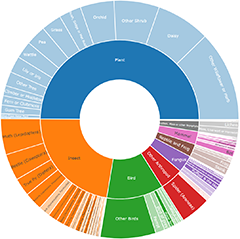Peas
There are over 12,000 pea species across the globe including herbs, shrubs, climbers and trees. They are good colonisers of bare areas assisted by their ability to trap nitrogen from the air and increase soil fertility. Many of the native species are dispersed by ants and will flourish after fire.
The native herbs and smaller shrubs are vulnerable to live-stock grazing and mainly occur in areas where grazing has been excluded or intermittent, such as within some Travelling Stock Reserves.
Although relatively few in number woody introduced peas, such as brooms, Gorse or Tree Lucerne are significant weeds. Exotic woody peas are a poor planting choice, as they are likely to stray far beyond the garden path.
All flowers of this family have the “sweet pea” butterfly shape, comprised of five often brightly coloured petals: the large upright standard at the back, two small lateral wings and the lower keel of two petals that are mostly fused.
Pea plants are generally distinguished from each other by their form (herb, shrub etc), their leaf characteristics, the colour of their flowers and the size and shape of their seed pods. Ideally postings of pea plants will include photographs that encapsulate all these features.
Photographs should show whether leaves are a single blade, or if not the number of leaflets of which they are composed. Photographs should also try and capture the pair of stipules or appendages that may occur at the base of the leaf stem. They can be leaf-like, membranous or spine like.
Announcements
There are currently no announcements.
Discussion
Glycine tabacina
Grona varians
Grona varians
Glycine tabacina
I have updated the location.
Oxytes brachypoda
Significant sightings
- Cytisus scoparius subsp. scoparius at Canberra Airport, ACT
- Swainsona recta
- Cullen tenax at Strathnairn, ACT
- Cytisus scoparius subsp. scoparius at Campbell, ACT
- Lespedeza juncea subsp. sericea at Strathnairn, ACT
- Bossiaea grayi at Kambah, ACT
- Sophora tomentosa at Port Macquarie, NSW
- Bossiaea grayi at Kambah, ACT
- Bossiaea grayi at Kambah, ACT
- Chorizema parviflorum at Albion Park Rail, NSW
Top contributors
- Tapirlord 715
- trevorpreston 589
- Mike 509
- MichaelBedingfield 356
- JaneR 333
- KylieWaldon 251
- ConBoekel 226
- BettyDonWood 214
- MatthewFrawley 210
- NedJohnston 208
Top moderators
- Tapirlord 3.5K
- MichaelMulvaney 1.7K
- BettyDonWood 833
- MichaelBedingfield 739
- natureguy 576
- plants 359
- Venture 303
- RWPurdie 258
- Darcy 193
- Csteele4 122



















































